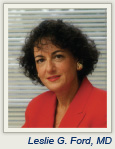Results from the Women’s Health Initiative1 showing a decreased incidence of breast cancer among postmenopausal hysterectomized women who took estrogen replacement therapy (ERT) may seem paradoxical, but “comply exactly” with laboratory research, according to V. Craig Jordan, OBE, PhD, DSc, Scientific Director and Vice Chairman of Oncology at the Lombardi Comprehensive Cancer Center, Georgetown University.
“Though paradoxical because estrogen is recognized to stimulate breast cancer growth, laboratory data support a mechanism of estrogen-induced apoptosis under the correct environmental circumstances. Long-term antiestrogen treatment or estrogen deprivation causes the eventual development and evolution of antihormone resistance,” wrote  Dr. Jordan and coauthor Leslie G. Ford, MD, of the NCI’s Division of Cancer Prevention, in an article recently published online in Cancer Prevention Research.1
Dr. Jordan and coauthor Leslie G. Ford, MD, of the NCI’s Division of Cancer Prevention, in an article recently published online in Cancer Prevention Research.1
To those familiar with Dr. Jordan’s work over the years with selective estrogen receptor modulators (SERMs) such as tamoxifen and raloxifene (for which he received the American Cancer Society Award for Chemoprevention at the 2006 ASCO Annual Meeting), it may even seem paradoxical that Dr. Jordan is the author of the paper linking estrogen to decreased incidence of breast cancer. Dr. Jordan acknowledged the irony, noting that he now introduces himself by saying, “It’s not that I’m antiestrogen. I’m proestrogen under the right circumstances.” (In fact, his Karnofsky Lecture at the 2008 Annual Meeting was titled “The Paradoxical Actions of Estrogen in Breast Cancer—Survival or Death?”2)
‘Fuel for the Fire’
“It is widely held that estrogen can be carcinogenic in breast tissue and is the ‘fuel for the fire’ to stimulate the growth of estrogen receptor (ER)-positive breast cancer cells. This knowledge, supported by an enormous body of laboratory data, provides the conceptual basis for the successful development of antihormonal strategies to treat breast cancer,” the research paper noted. The Women’s Health Initiative’s observed decrease in invasive cancer, which was sustained for 5 years after ERT was stopped, “seems to run counter to the perceived wisdom of the role of estrogen in breast carcinogenesis,” the authors wrote. The reduction in breast cancer seen in the Women’s Health Initiative study, however, “is consistent nevertheless with parallel laboratory studies completed over the last 20 years,” they noted. An article in the Journal of the American Medical Association on the Women’s Health Initiative study reported a statistically significant lower cumulative breast cancer incidence of 0.27% in women taking conjugated equine estrogens, compared with 0.35% in the placebo group.3
“The key to all of this is that the clones of breast cancer cells that grow out in the laboratory or in a premenopausal woman’s body are feeding on all of this fuel—the estrogen—and keep replicating,” Dr. Jordan explained in an interview with The ASCO Post. With menopause or use of an antihormone therapy, the cells that can only grow with the fuel of estrogen start to die out. “The cells that survive the transition have a nimbleness in their capacity to adapt to a low-estrogen environment. These cells start to reproduce preferentially, and over a period of time, they are growing on a minute signal of estrogen that would be available in a postmenopausal woman, or in a woman taking an aromatase inhibitor or tamoxifen,” he said.
“With a postmenopausal woman, what you basically have is estrogen withdrawal with a little bit of estrogen around,” he continued. “What you see with ERT in the Women’s Health Initiative is a profound effect of the estrogen that is available to what are probably nascent cells.” If a woman takes estrogen replacement therapy, these cells are suddenly swamped by the incoming estrogen; they are overwhelmed, go through apoptosis, and die.
Interpreting the Findings
“The result from the Women’s Health Initiative Trial of ERT in hysterectomized women, which showed a sustained reduction in the incidence of breast cancer, provides additional evidence that the strategy to decipher the mechanism of physiologic estrogen to induce apoptosis has significance for both treatment and prevention,” Drs. Jordan and Ford wrote.
Dr. Jordan stressed that the findings from Women’s Health Initiative apply only to postmenopausal women who have had hysterectomies. These women could take estrogen without fear that it might cause breast cancer, and such an approach might even decrease the risk, but recommending estrogen to reduce breast cancer risk “would be premature,” Dr. Jordan said. “What we have to do now is take on board this very important clinical result [from the Women’s Health Initiative trial] and study the mechanism in detail. It may be that if hysterectomized women take estrogen replacement therapy, they at least have no increase in breast cancer,” he suggested.
 “Absolutely no one should be saying that estrogen replacement therapy is a potential chemopreventive for breast cancer in women,” Dr. Ford said. The Women’s Health Initiative trial result “is a piece of information that tells us about the safety of estrogen replacement therapy. So women can have the benefits of estrogen replacement therapy with regard to their bones and their well-being, and in reducing the frequency and severity of hot flashes,” Dr. Ford said. “But they still need mammograms.”
“Absolutely no one should be saying that estrogen replacement therapy is a potential chemopreventive for breast cancer in women,” Dr. Ford said. The Women’s Health Initiative trial result “is a piece of information that tells us about the safety of estrogen replacement therapy. So women can have the benefits of estrogen replacement therapy with regard to their bones and their well-being, and in reducing the frequency and severity of hot flashes,” Dr. Ford said. “But they still need mammograms.”
Dr. Jordan pointed out that estradiol “is available for physicians to use for the treatment of metastatic breast cancer.” Physicians can use it “as a discretionary measure. If their patients have had multiple endocrine therapies, they should be able to consider that as an option that may provide some months of relief for their patients instead of going on to chemotherapy,” he said.
“Nobody should be rushing off to the doctor saying, ‘I want to prevent breast cancer. Forget raloxifene. Give me some estrogen,’” Dr. Jordan continued. He also stressed that for women who are currently taking antihormone therapy to prevent metastatic breast disease, “You don’t stop the treatment plan.”
Ongoing Research
Finding out more about how estrogen functions in cells that have been deprived of estrogen for years will provide additional tools for developing therapeutic paradigms, Dr. Jordan said. He cited the Study of Letrozole Extension (SOLE) trial, which is comparing breast cancer recurrence rates among women who have completed 4 to 6 years of adjuvant endocrine therapy with a SERM and/or aromatase inhibitor and were then randomly assigned to letrozole either continuously or intermittently with 3-month drug holidays every year for 5 years. “Let’s see if the woman’s own estrogen, like little pulses every 3 months, can improve recurrence rates in the intermittent-letrozole arm compared with the continuous-letrozole arm. That may just drive antihormone therapy more,” Dr. Jordan said. ■
Financial Disclosure: Dr. Jordan and Dr. Ford reported no potential conflicts of interest.
References
1. Jordan VC, Ford LG: Paradoxical clinical effect of estrogen on breast cancer risk: A “new” biology of estrogen-induced apoptosis. Cancer Prevention Research. April 10, 2011 (early release online).
2. Jordan VC: The 38th David A. Karnofsky Lecture: The paradoxical actions of estrogen in breast cancer—survival or death? J Clin Oncol 26(18S):3073-3082, 2008.
3. LaCroix AZ, Chlebowski RT, Manson JE, et al: Health outcomes after stopping conjugated equine estrogens among postmenopausal women with prior hysterectomy. JAMA 305:1305-1314, 2011.

